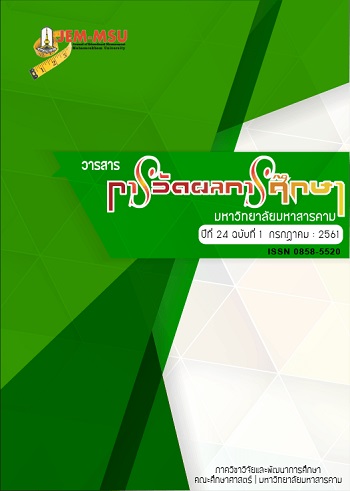มโนทัศน์เบื้องต้นของการประเมินอภิมาน
Main Article Content
บทคัดย่อ
การประเมินในปัจจุบันมีการเปลี่ยนแปลงในทิศทางที่หลากหลาย โดยได้รับการยอมรับและนำไปใช้กันอย่าง
แพร่หลายในหน่วยงานทั้งภาครัฐและเอกชน ในฐานะที่เป็นเครื่องมือในการจัดหาสารสนเทศสาหรับการตัดสินใจและการ
กำหนดนโยบายการพัฒนาองค์กร ดังนั้น ความถูกต้องของการตัดสินใจ ย่อมขึ้นกับสารสนเทศที่ได้จากการประเมินที่มี
คุณภาพ รวมถึงผู้ประเมินที่มีคุณภาพ ด้วยเหตุผลดังกล่าว จึงทำให้เกิดการติดตามและตรวจสอบคุณภาพของการ
ประเมินให้เป็นไปตามมาตรฐาน ซึ่งเรียกว่า “การประเมินงานประเมิน หรือ การประเมินอภิมาน (Meta-Evaluation)”
Article Details
เนื้อหาและข้อมูลในบทความที่ลงตีพิมพ์ในวารสารการวัดผลการศึกษา มหาวิทยาลัยมหาสารคาม ถือเป็นข้อคิดเห็นและความรับผิดชอบของผู้เขียนบทความโดยตรง ซึ่งกองบรรณาธิการวารสาร ไม่จำเป็นต้องเห็นด้วย หรือร่วมรับผิดชอบใดๆ
บทความ ข้อมูล เนื้อหา รูปภาพ ฯลฯ ที่ได้รับการตีพิมพ์ในวารสารการวัดผลการศึกษา มหาวิทยาลัยมหาสารคาม ถือเป็นลิขสิทธิ์ของวารสารการวัดผลการศึกษา มหาวิทยาลัยมหาสารคาม หากบุคคลหรือหน่วยงานใดต้องการนำทั้งหมดหรือส่วนใดส่วนหนึ่งไปเผยแพร่ต่อหรือกระทำการใดๆ จะต้องได้รับอนุญาตเป็นลายลักษณ์อักษรจากวารสารการวัดผลการศึกษา มหาวิทยาลัยมหาสารคาม ก่อนเท่านั้น
เอกสารอ้างอิง
Edition) ปี ค.ศ. 2010”. วารสารวิธีวิทยาการวิจัย. 24(2): 273-278
2. ศิริชัย กาญจนวาสี. (2552). ทฤษฎีการประเมิน. พิมพ์ครั้งที่ 6. กรุงเทพมหานคร: สานักพิมพ์แห่งจุฬาลงกรณ์
มหาวิทยาลัย.
3.สมหวัง พิธิยานุวัฒน์. (2551). วิทยาการประเมินศาสตร์แห่งคุณค่า. พิมพ์ครั้งที่ 4. กรุงเทพมหานคร:
สานักพิมพ์แห่งจุฬาลงกรณ์มหาวิทยาลัย.
4. สุวิมล ว่องวานิช. (2550). การประเมินอภิมาน: แนวคิดและหลักการ. พิมพ์ครั้งที่ 2. กรุงเทพมหานคร:
สานักพิมพ์แห่งจุฬาลงกรณ์มหาวิทยาลัย.
5. Cooksy, Valerie J. (2009). “Meta-Evaluation in Practice Selection and Application of Criteria”
Journal of MultiDisciplinary Evaluation. 6(11). pp. 1-15.
6. Seberova, Alena and Martin Malcik. (2010). “Meta-Evaluation and Quality Standard of the
Final Evaluation Report, The New Educational Review. 6(3-4).p. 149-164.
7. Stufflebeam, Daniel L. (1974). Meta-Evaluation. Kalamazoo: Western Michigan Univeraity.
The Evaluation Center.
8. ______. (2011). “The Metaevaluation Imperative,” American Journal of Evaluation. 22(2). p.
183–209.
9. Yarbrough, D. B., Shulha, L. M., Hopson, R. K., & Caruthers, F. A. (2010). The program
evaluation standards: A guide for evaluators and evaluation users. (3rd ed.).
Thousand Oaks, CA: Sage.


